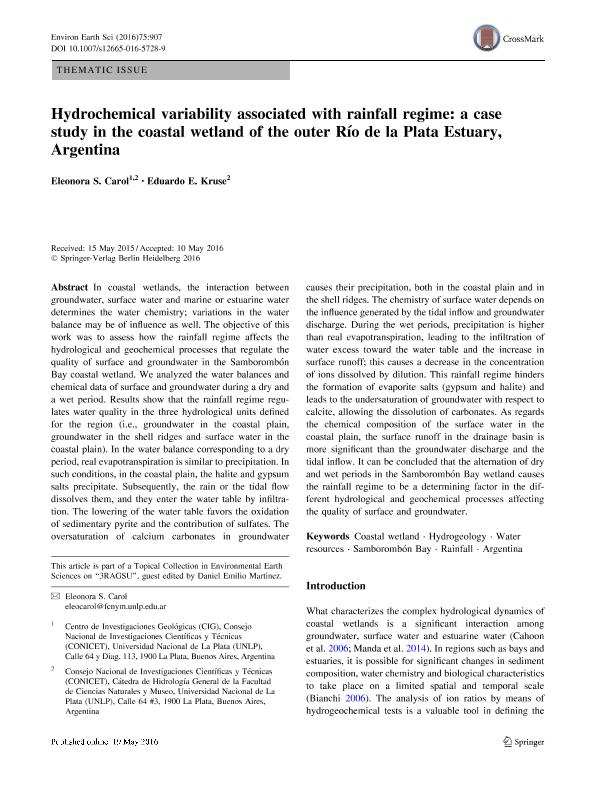Artículo
Hydrochemical variability associated with rainfall regime: a case study in the coastal wetland of the outer Río de la Plata Estuary, Argentina
Fecha de publicación:
05/2016
Editorial:
Springer Verlag Berlín
Revista:
Environmental Earth Sciences
ISSN:
1866-6299
e-ISSN:
1866-6299
Idioma:
Inglés
Tipo de recurso:
Artículo publicado
Clasificación temática:
Resumen
In coastal wetlands, the interaction between groundwater, surface water and marine or estuarine water determines the water chemistry; variations in the water balance may be of influence as well. The objective of this work was to assess how the rainfall regime affects the hydrological and geochemical processes that regulate the quality of surface and groundwater in the Samborombón Bay coastal wetland. We analyzed the water balances and chemical data of surface and groundwater during a dry and a wet period. Results show that the rainfall regime regulates water quality in the three hydrological units defined for the region (i.e., groundwater in the coastal plain, groundwater in the shell ridges and surface water in the coastal plain). In the water balance corresponding to a dry period, real evapotranspiration is similar to precipitation. In such conditions, in the coastal plain, the halite and gypsum salts precipitate. Subsequently, the rain or the tidal flow dissolves them, and they enter the water table by infiltration. The lowering of the water table favors the oxidation of sedimentary pyrite and the contribution of sulfates. The oversaturation of calcium carbonates in groundwater causes their precipitation, both in the coastal plain and in the shell ridges. The chemistry of surface water depends on the influence generated by the tidal inflow and groundwater discharge. During the wet periods, precipitation is higher than real evapotranspiration, leading to the infiltration of water excess toward the water table and the increase in surface runoff; this causes a decrease in the concentration of ions dissolved by dilution. This rainfall regime hinders the formation of evaporite salts (gypsum and halite) and leads to the undersaturation of groundwater with respect to calcite, allowing the dissolution of carbonates. As regards the chemical composition of the surface water in the coastal plain, the surface runoff in the drainage basin is more significant than the groundwater discharge and the tidal inflow. It can be concluded that the alternation of dry and wet periods in the Samborombón Bay wetland causes the rainfall regime to be a determining factor in the different hydrological and geochemical processes affecting the quality of surface and groundwater.
Palabras clave:
ARGENTINA
,
COASTAL WETLAND
,
HYDROGEOLOGY
,
RAINFALL
,
SAMBOROMBÓN BAY
,
WATER RESOURCES
Archivos asociados
Licencia
Identificadores
Colecciones
Articulos(CIG)
Articulos de CENTRO DE INVEST.GEOLOGICAS (I)
Articulos de CENTRO DE INVEST.GEOLOGICAS (I)
Citación
Carol, Eleonora Silvina; Kruse, Eduardo Emilio; Hydrochemical variability associated with rainfall regime: a case study in the coastal wetland of the outer Río de la Plata Estuary, Argentina; Springer Verlag Berlín; Environmental Earth Sciences; 75; 10; 5-2016; 1-11
Compartir
Altmétricas




